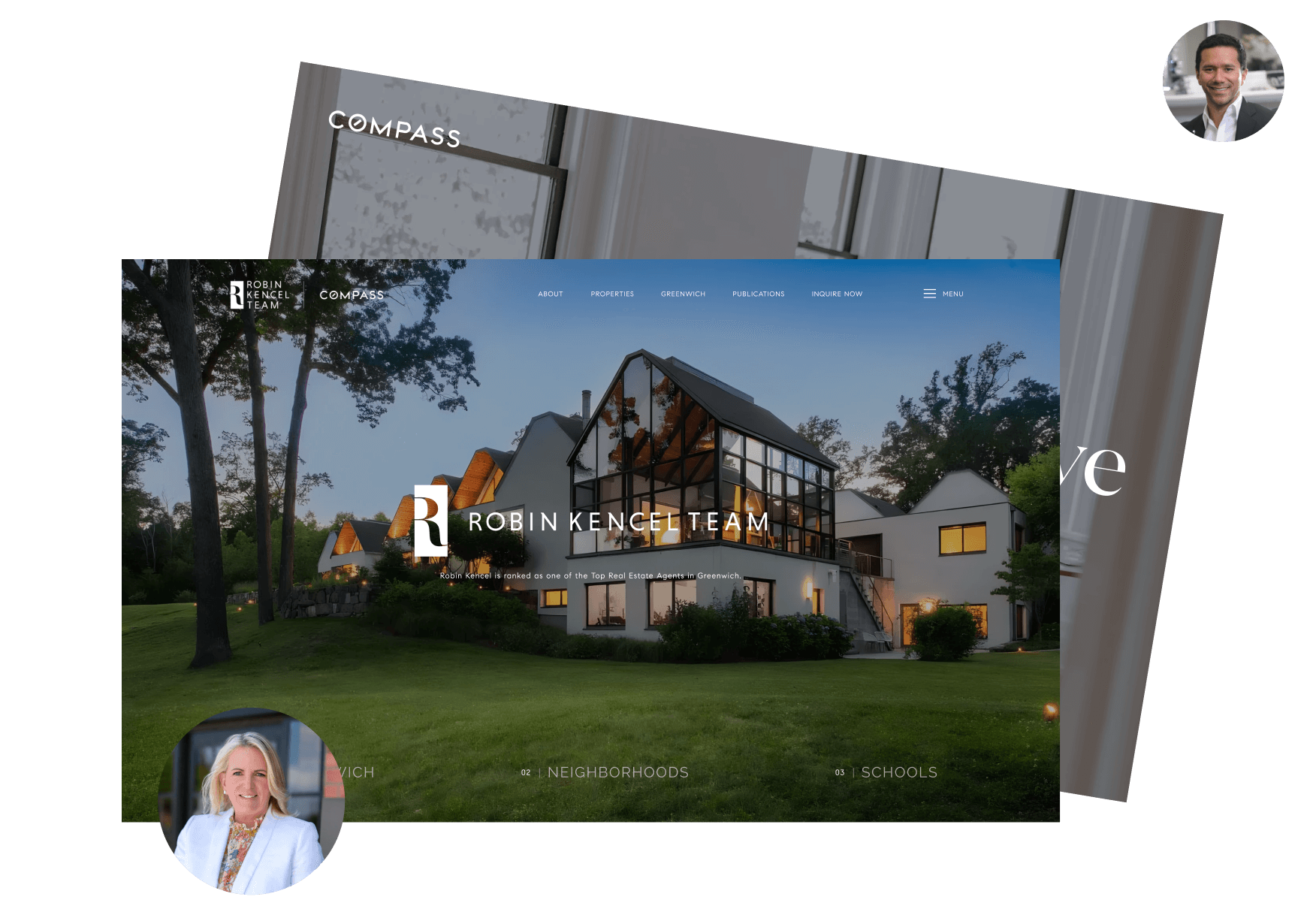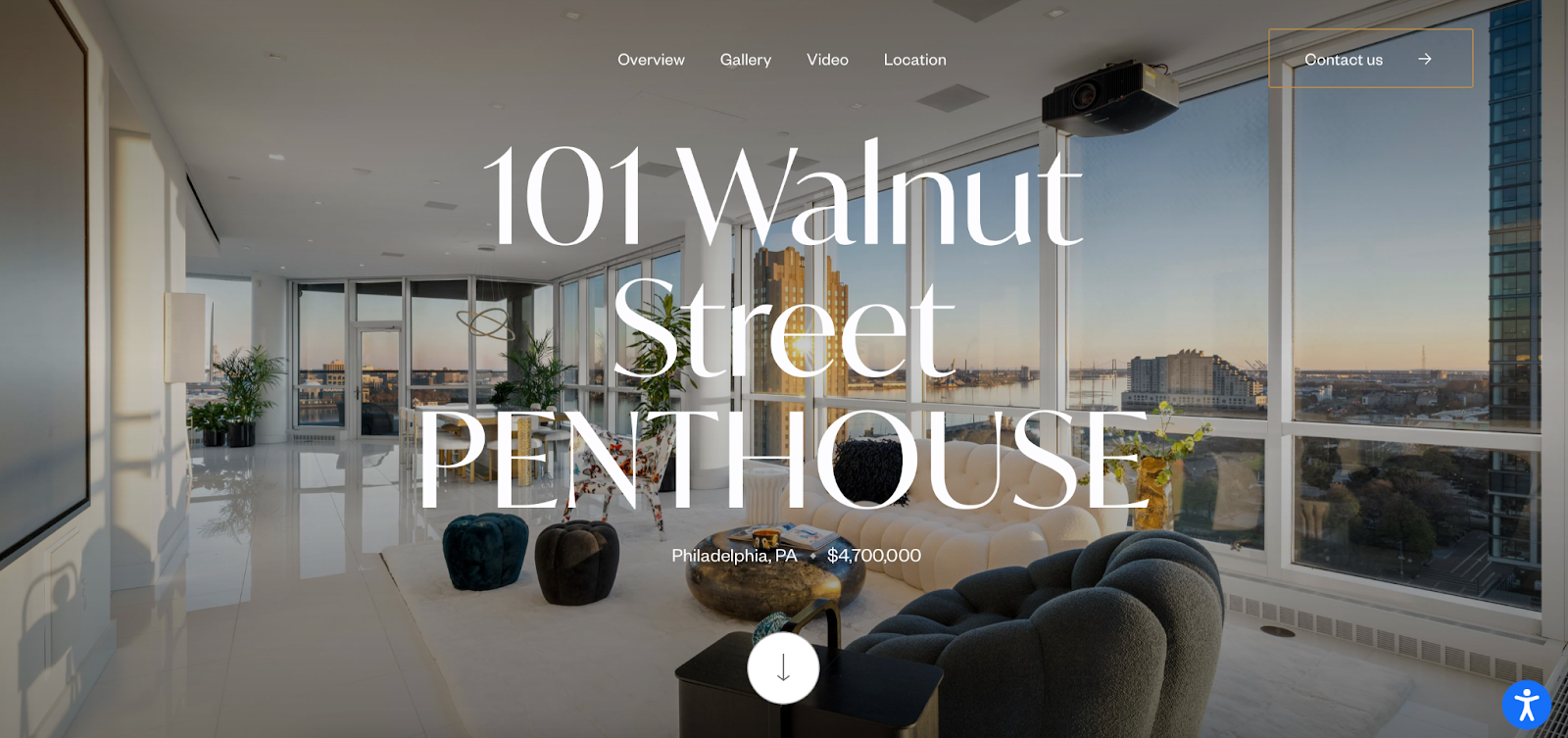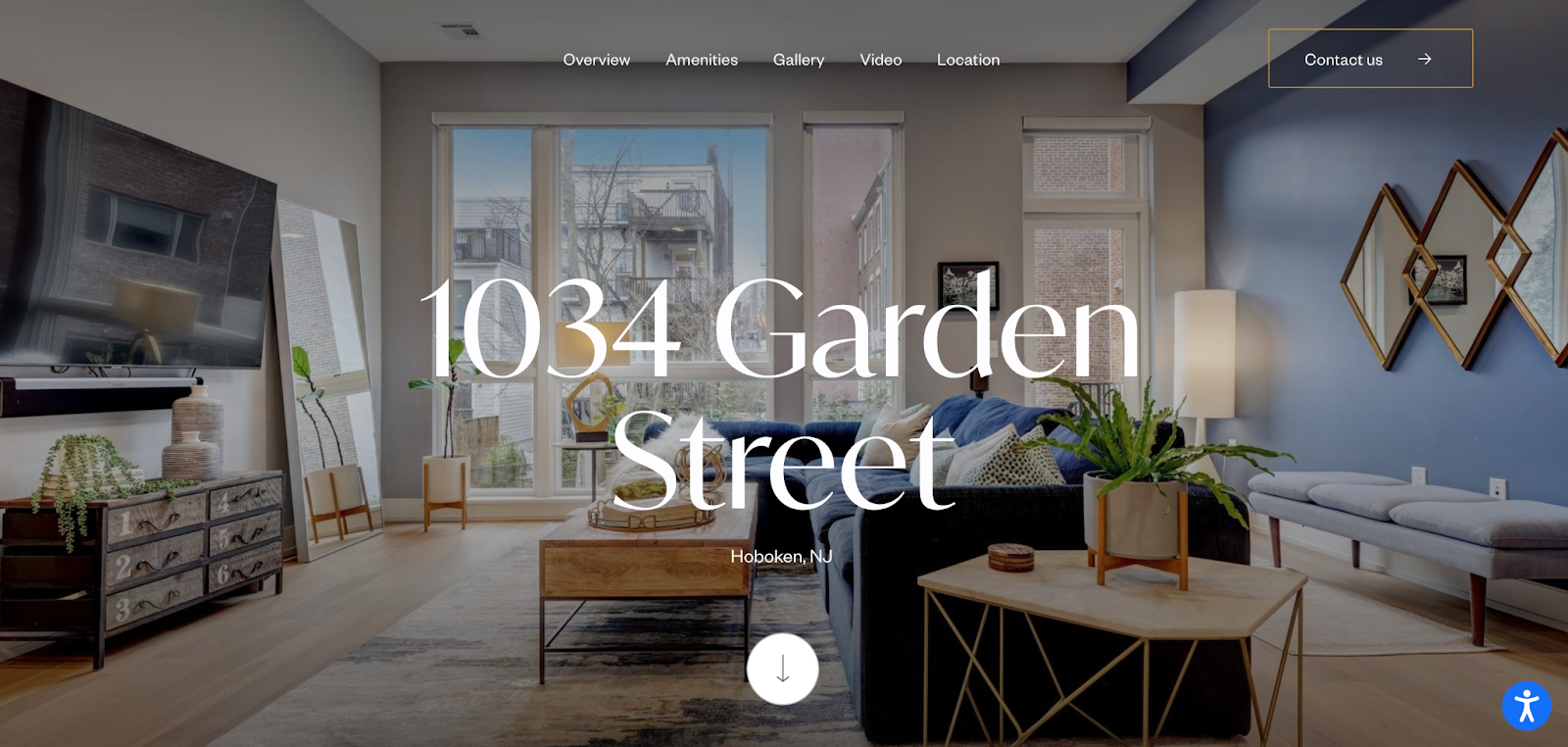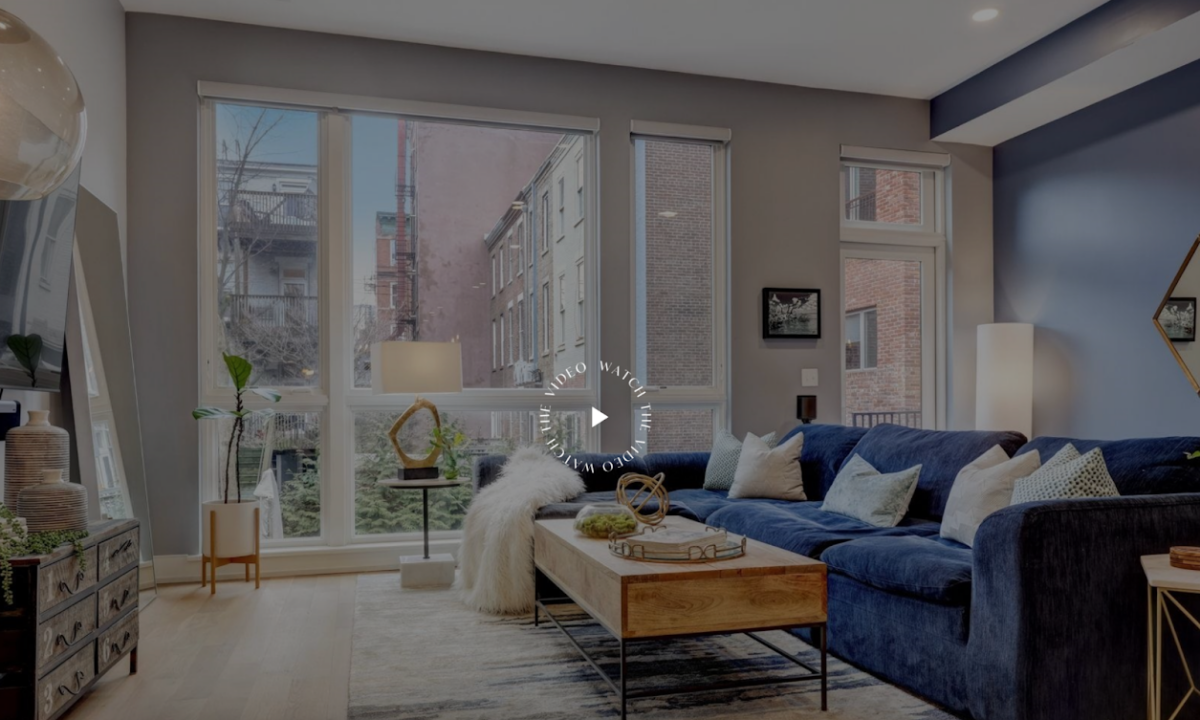The property description sets the stage: It’s the opening pitch, the story starter, and a subtle persuasion tool all rolled into one. At Luxury Presence, we know the power of well-written property listings. We manage more than 40,000 live websites for real estate professionals and helped generate over 100 million website visitors in 2024 alone. That experience has taught us a simple truth: Words matter. A compelling property description can make the difference between a casual browser and a serious inquiry.
In this ultimate guide to writing property descriptions, we’ll walk you through every step of the process — from crafting attention-grabbing headlines to structuring narratives and closing with calls to action that convert. With examples, templates, and eight practical tips, you’ll learn how to turn property facts into persuasive marketing copy that captures attention and drives results.
Find It Fast
Why spend time perfecting your property description?
A well-crafted property description is a cornerstone of your marketing and brand strategy. Every word you choose reflects your voice, your professionalism, and the type of experience clients can expect when working with you.
Beautifully written descriptions do more than inform — they tell stories that captivate potential buyers and ignite their imaginations. With vivid language and purposeful detail, you can highlight a property’s unique features, lifestyle offerings, and emotional appeal, all while reinforcing your brand identity.
A property description directly reflects the care and expertise you bring to every transaction. It shows buyers and sellers that you understand how to position a home in the best possible light and market it effectively in a competitive landscape. By engaging a buyer’s emotions and speaking to their desires, a strong property description draws attention, generates inquiries, and increases the likelihood of a successful sale — all while subtly elevating your brand with every listing you publish.
Property descriptions should include:
- An attention-grabbing headline (or title)
- A concise, direct opening statement
- Property details with emotive language
- Artful, professional photography
- A powerful call to action
How to write the perfect property description
A strong property description is really dynamic storytelling tailored to a targeted audience. To make your property description stand out among thousands of mediocre ones, it must be polished, contain no errors, follow a familiar structure, and leverage creative words that evoke emotion.
1. Craft an attention-grabbing headline
A captivating title acts as the first point of contact, grabbing the attention of potential buyers in a sea of listings. It sets the tone, sparking curiosity and creating an emotional connection that encourages engagement. Because most readers scan content, headlines should also highlight the most enticing features, making a property more memorable and increasing its chances of standing out.
Headlines should be short and snappy — they should not exceed ten words. There’s not much time to capture attention, so use powerful words and create urgency.
Examples
- “Luxury Living Redefined: Exquisite Waterfront Estate With Private Dock”
- “Serenity Awaits: Secluded Mountain Retreat With Panoramic Views”
- “Urban Oasis: Chic Loft in the Heart of Downtown’s Vibrant District”
- “Historic Charm Meets Modern Elegance: Renovated Victorian Gem in Prime Location”
- “Don’t Miss Out! Rare Opportunity: Stunning Beachfront Property at Unbeatable Price”
- “Act Fast! Impeccable Family Home in Desirable Neighborhood — Won’t Last Long”
2. Write a succinct opening statement
The first line of your property description should keep the reader engaged as they transition from the headline to the property details. Remember, buyers tend to know exactly what they are looking for and will move on if they do not find content that matches their needs. Reel house hunters in further with a first sentence that expands on the headline. Let the reader know what they are looking at and persuade them to keep reading.
Strive for well-written content that is free of grammatical and spelling errors. Setting the scene for the property details, the opening statement should create a vivid picture in the reader’s mind, drawing them into the narrative and sparking their imagination about the lifestyle the property offers. Also, avoid reusing words from your headline in your opening statement; readers tend to lose interest with repeated language.
Examples
- “Step into your own private paradise with this meticulously crafted {property type} nestled in the heart of {location}.”
- “Embrace the epitome of luxury living with this exquisite {property type} boasting unparalleled views and world-class amenities.”
- “Experience the perfect blend of charm and sophistication with this beautifully appointed {property type}, offering a lifestyle of comfort and convenience in every detail.”
- “Discover a serene retreat in this thoughtfully designed {property type}, offering spacious interiors and breathtaking outdoor spaces.”
- “Unwind in style with this stunning {property type}, featuring elegant finishes and an inviting ambiance perfect for relaxation and entertainment.”
3. Include all the details in narrative form
Continue writing succinctly as you craft the meat of your property description. Aim for 250 words or less — your MLS and other popular real-estate listing sites likely have text length limitations. Note that some agents find that it’s easiest to start with this step. Once the description is written, it’s easier to come up with a headline and opening statement.
A home’s square footage and the number of bedrooms and bathrooms exist separately in the listing’s data fields. Use this description space to really tell the home’s story and highlight what makes it valuable and desirable. In order to help buyers imagine themselves in each room of the home, use adjectives to characterize the modern kitchen, spa-like bathroom, cozy study, and airy bedroom. Here’s what to highlight in your property description:
- Recent renovations and upgrades
- Notable brands of appliances, flooring, lighting, etc.
- Lot size
- Basement/garage
- Additional features: pool, fireplace, deck, etc.
- Unique characteristics: historic property, ocean views, etc.
Need more? We have a collection of more than 250 key descriptive adjectives.
Examples

Seaside escape template
Discover the joy of coastal luxury living with this exquisite waterfront estate located in prestigious {location}. Spanning {number} square feet, this meticulously crafted home boasts {number} bedrooms and {number} bathrooms, providing ample space for both relaxation and entertainment.
Upon entering, you are greeted by a grand foyer that leads to the expansive living areas adorned with elegant finishes and panoramic views of the glistening water. The chef’s kitchen is a culinary masterpiece, featuring state-of-the-art appliances, custom cabinetry, and a spacious island perfect for hosting intimate gatherings or large soirées.
Outside, the lushly landscaped grounds beckon you to unwind in the idyllic outdoor oasis. Lounge by the sparkling pool, soak in the sun on the private dock or dine alfresco under the covered patio while savoring the gentle sea breeze and mesmerizing sunset vistas.
Located just minutes from {local attractions}, {schools}, and {amenities}, this waterfront paradise offers convenience without compromising on privacy or exclusivity.
Charleston historic home example
Nestled within Charleston’s iconic South of Broad neighborhood, this historic gem embodies Southern charm and modern elegance. Boasting 4 bedrooms and 3 bathrooms, this meticulously maintained residence offers a perfect blend of timeless architecture and contemporary comfort. Step onto the expansive front porch, where rocking chairs beckon you to relax and soak in the idyllic surroundings of the quiet one-way street.
Inside, the home exudes warmth and character with its original hardwood floors, soaring ceilings, and elegant crown molding. The state-of-the-art kitchen is a culinary enthusiast’s dream, featuring top-of-the-line appliances, custom cabinetry, and marble countertops. Entertain guests in the spacious living areas, adorned with historic details and flooded with natural light from the oversized windows.
Retreat to the serene master suite, complete with a luxurious en-suite bathroom and ample closet space. Three additional bedrooms offer versatility for guests or home offices, while the landscaped backyard provides a tranquil oasis for outdoor gatherings and al fresco dining.
Located in the heart of one of Charleston’s most coveted neighborhoods, this home offers unparalleled access to the city’s finest dining, shopping, and cultural attractions. From leisurely strolls along the cobblestone streets to exploring nearby parks and waterfront promenades, South of Broad living embodies the quintessential Charleston experience.
4. Incorporate professional photography
In today’s digital age, where first impressions are often made online, high-quality images are essential for capturing the attention of prospective buyers. Stunning visuals not only enhance the appeal of the listing but also convey a sense of professionalism and attention to detail on the part of the seller and the agent.
Professional photography will differentiate your listing from competing properties. But you can also achieve a similarly luxurious look if you spend some time studying how to take high-end real estate photos yourself.
Arrange the photographs in the same order as the rooms are arranged in the home so the buyer can “walk through” the home digitally. It’s also beneficial to add short descriptions to each image so buyers know exactly what to expect when they tour the house.
5. Close with an enticing call to action
A call to action (CTA) is a succinct statement that prompts the reader to do something specific, such as scheduling a viewing, contacting the agent for more information, or making an offer. It serves as the final push to engage potential buyers and convert their interest into action.
By providing a clear and compelling directive, a CTA not only encourages immediate engagement but also helps move the buyer further down the sales funnel, ultimately increasing the likelihood of a successful transaction.
Examples
- “Schedule your private tour today and experience the beauty of this home firsthand.”
- “Don’t miss out — contact us now to learn more about this incredible opportunity!”
- “Ready to make this house your home? Reach out to us to discuss the next steps.”
- “Act fast — homes like this don’t stay on the market for long. Contact us to schedule a viewing.”
- “Start living the {type/location} lifestyle today — get in touch with us to make this dream home yours.”
- “Take the first step toward owning your perfect home — call us now for more details.”
- “Seize the opportunity to own this exquisite property — reach out to us, and let’s make it happen!”
8 tips to make your property descriptions even better

- Double-, triple-, and quadruple-check your spelling and grammar — and then have someone check it again. Mistakes reflect poorly on a brand and reflect a lack of attention to detail.
- It’s important not to oversell the home in your description. Be as honest as possible, and use attractive words that fit the home.
- When you write a property description, you must comply with the Fair Housing Act. Not only does discriminatory verbiage turn buyers away, but it may also land you a fine. Keep a lookout for any wording that could be interpreted as discriminatory against any of the protected classes.
- Keep it concise. If you include a lot of information, be sure to format it in a way that is easy to read and scan.
- Use descriptors judiciously. Buyers want to enjoy reading about your listing. However, they do not need to be inundated with unnecessary adjectives.
- Incorporate words associated with a high level of value. These words can be name-brand appliances or vocabulary like “luxury,” “impeccably crafted,” “professionally landscaped,” “chef’s kitchen,” and “hand-scraped hardwoods.”
- Call out special promotions. Adding a list of incentives can motivate buyers to act quickly and speed up the home sale. Some examples of special offers include offering seller financing, a home warranty, or a flexible closing date.
- Once you have your stellar property listing, consider adding it to a single property website where you can market your luxury property. Posting the glossy professional photos along with your captivating listing description will both impress your sellers and help you generate and convert leads.
Using AI to write property descriptions
Using an artificial intelligence tool, such as ChatGPT or Listing AI, is an excellent way to leverage this useful technology. Input key details about the property and include your target word count, the tone, and the intended audience. AI will do the rest. Remember, however, that AI is not infallible. You must always check your content for mistakes, errors, hallucinations, and fair housing compliance.
Boost productivity with AI
Our e-book contains tested prompts for outsourcing common real estate tasks to ChatGPT and best practices for using artificial intelligence properly in your business.

Sample prompt for ChatGPT:
Write a roughly 250-word property description, complete with an attention-grabbing headline and compelling opening statement, in a professional tone intended to attract luxury buyers for a historic home with four bedrooms, three bath, wood-paneled library, chef’s kitchen, landscaped garden, in the Buena Vista neighborhood of Winston-Salem, North Carolina.
The result:
Headline: Timeless Elegance Awaits: Historic Gem in Buena Vista, Winston-Salem
Opening Statement: Embrace a lifestyle of refined sophistication and timeless charm in the heart of Buena Vista, Winston-Salem. This distinguished historic home offers a rare opportunity to own a piece of the city’s rich architectural heritage, seamlessly blending classic elegance with modern luxury.
Property Description: Nestled amidst the tree-lined streets of the coveted Buena Vista neighborhood, this distinguished residence exudes an air of grandeur and prestige. From the moment you step through the door, you are enveloped in the rich history and exquisite craftsmanship that define this magnificent home.
Boasting 4 bedrooms and 3 baths, including a luxurious master suite, this expansive residence offers ample space for both relaxation and entertainment. The wood-paneled library provides a serene retreat for quiet contemplation, while the chef’s kitchen is a culinary masterpiece, featuring top-of-the-line appliances and custom cabinetry.
Outside, the meticulously landscaped garden beckons you to unwind in the tranquility of nature, offering a picturesque backdrop for outdoor gatherings and al fresco dining. Whether you’re savoring a morning coffee on the charming patio or hosting a soirée beneath the stars, the landscaped garden provides a serene escape from the hustle and bustle of city life.
Located in one of Winston-Salem’s most prestigious neighborhoods, this historic home offers the perfect blend of luxury and convenience. With its prime location just minutes from downtown shops, restaurants, and cultural attractions, this is an opportunity not to be missed. Experience the timeless allure of Buena Vista living – schedule your private tour today and make this historic gem your own.
Property descriptions + Luxury Presence
Property listings are a crucial part of an agent’s marketing strategy and overall brand. Contact Luxury Presence today and experience firsthand how our cutting-edge tools and tailored solutions can elevate your brand, streamline your processes, and captivate high-end clientele.
Luxury Presence can elevate your marketing strategy
Learn how we can help take your real estate business to the next level. Schedule a time to speak with one of our branding experts today.





